Charles E W Bean, Diaries, AWM38 3DRL 606/227/1 - Folder - Part 17
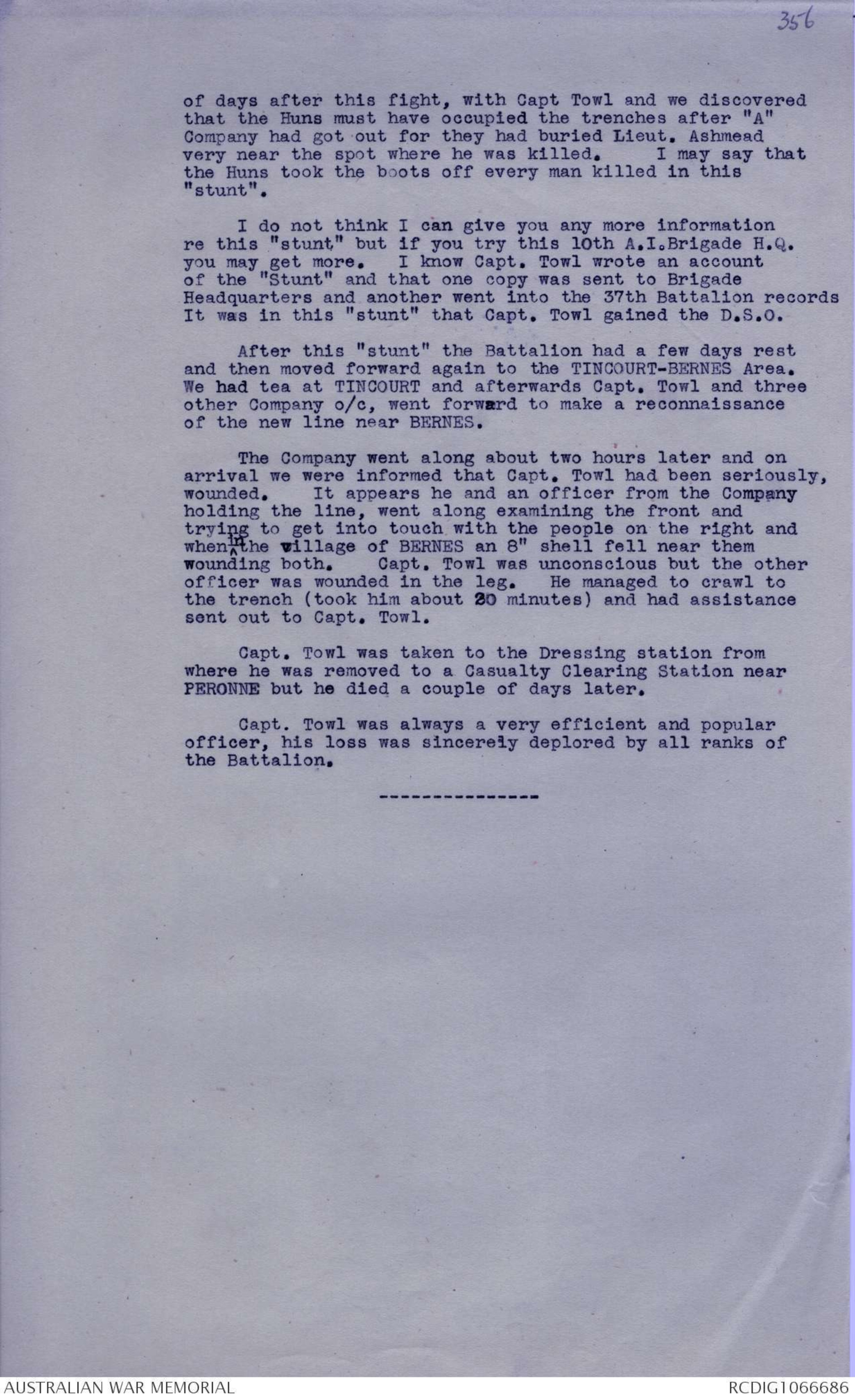
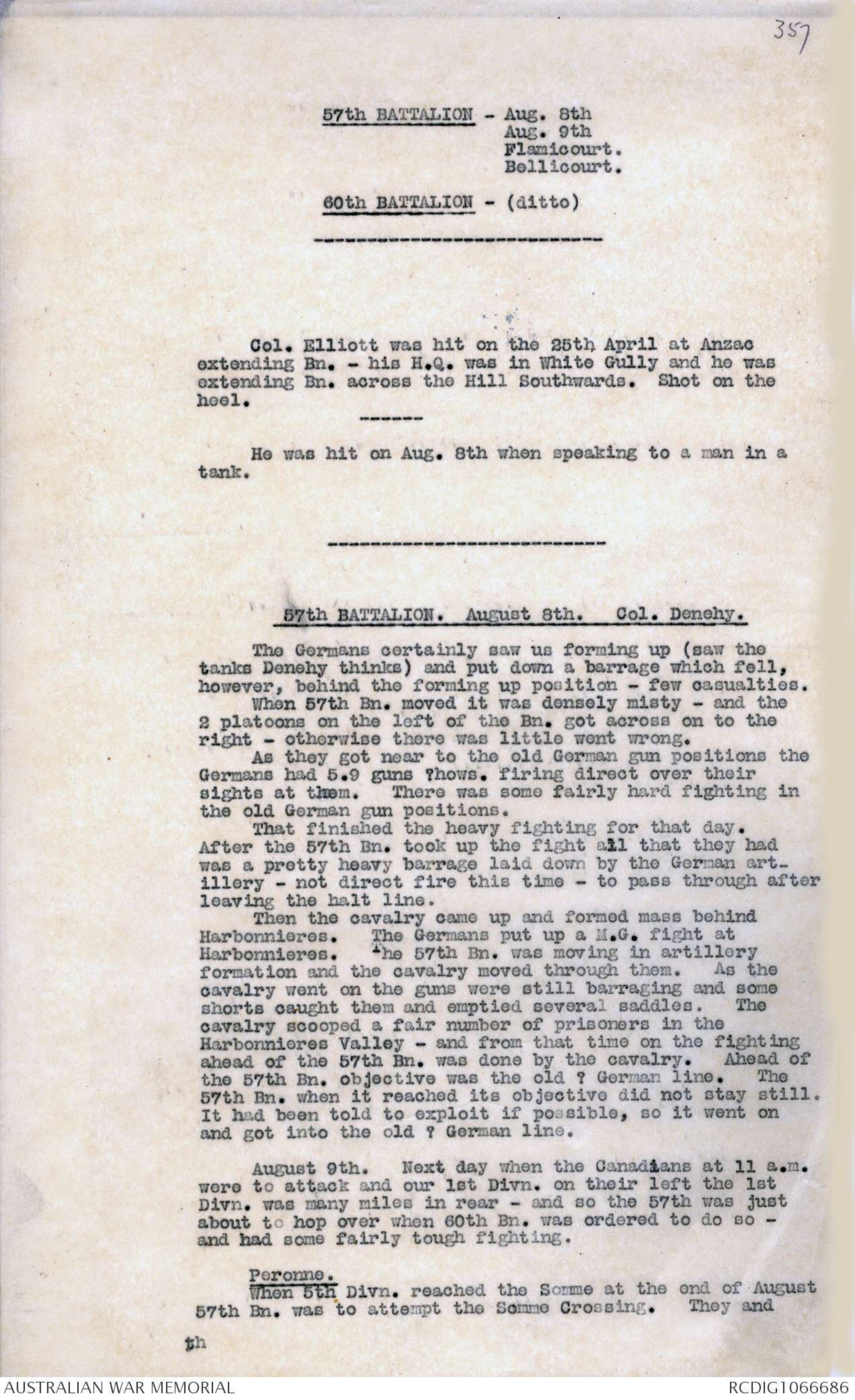
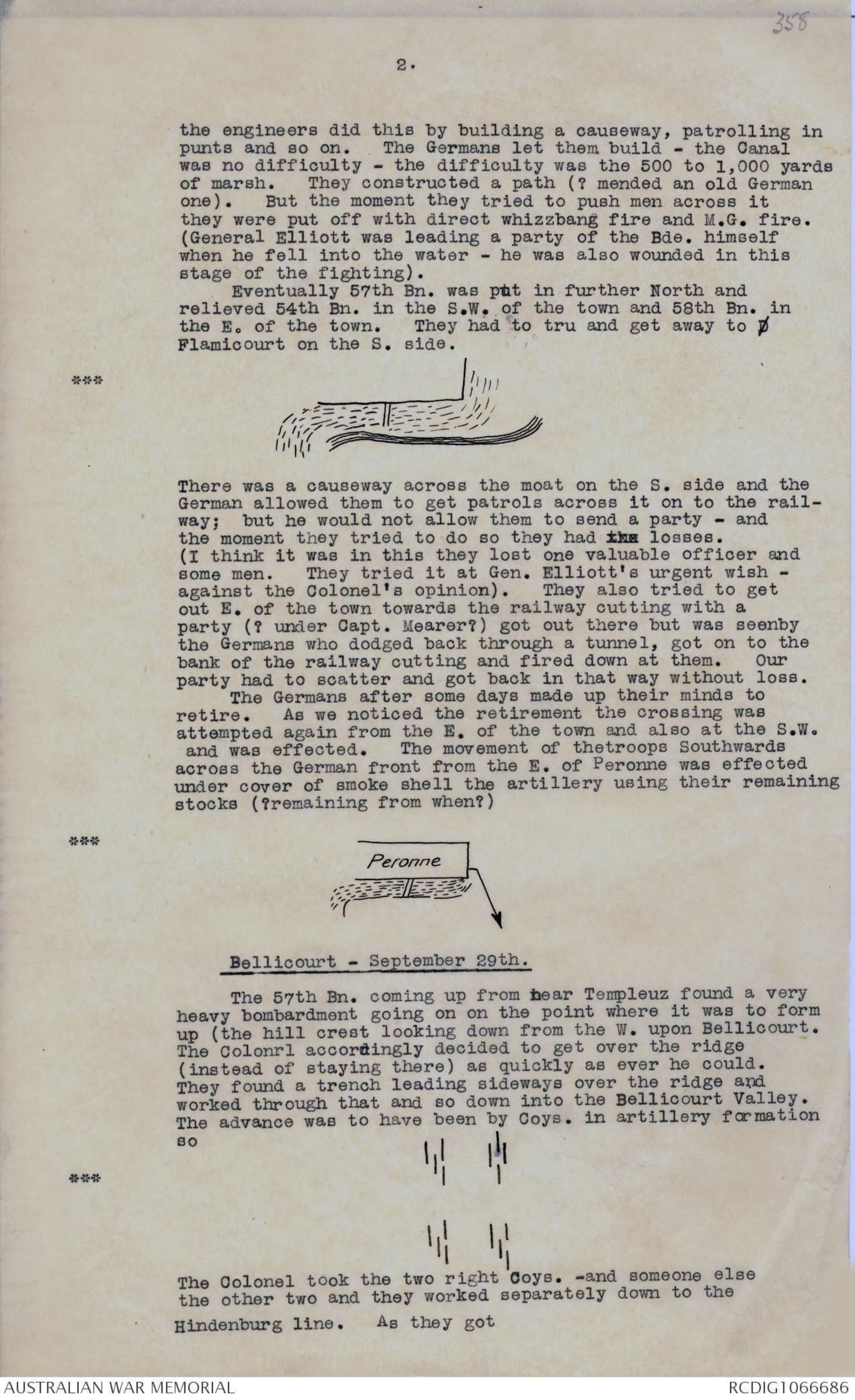
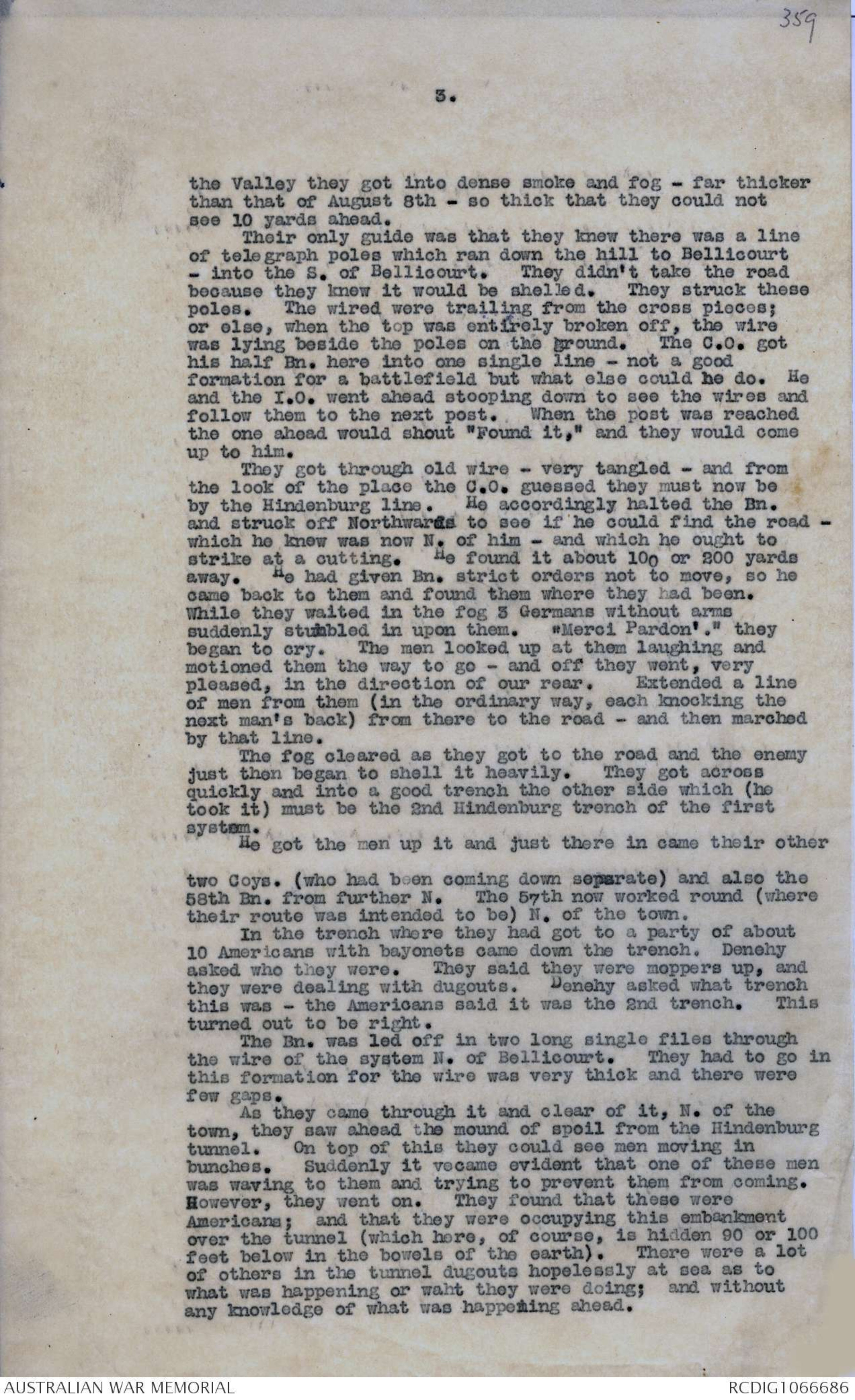
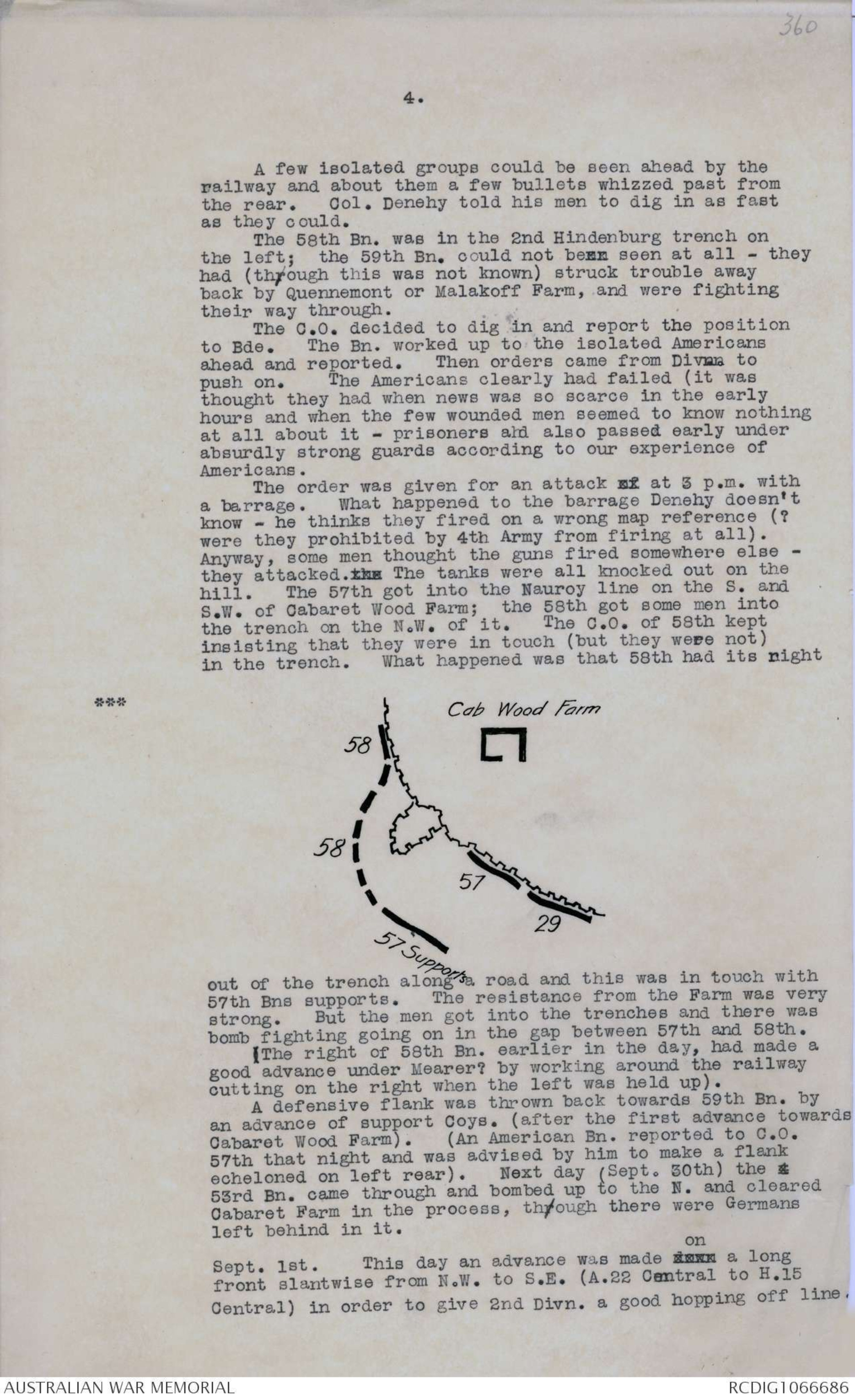
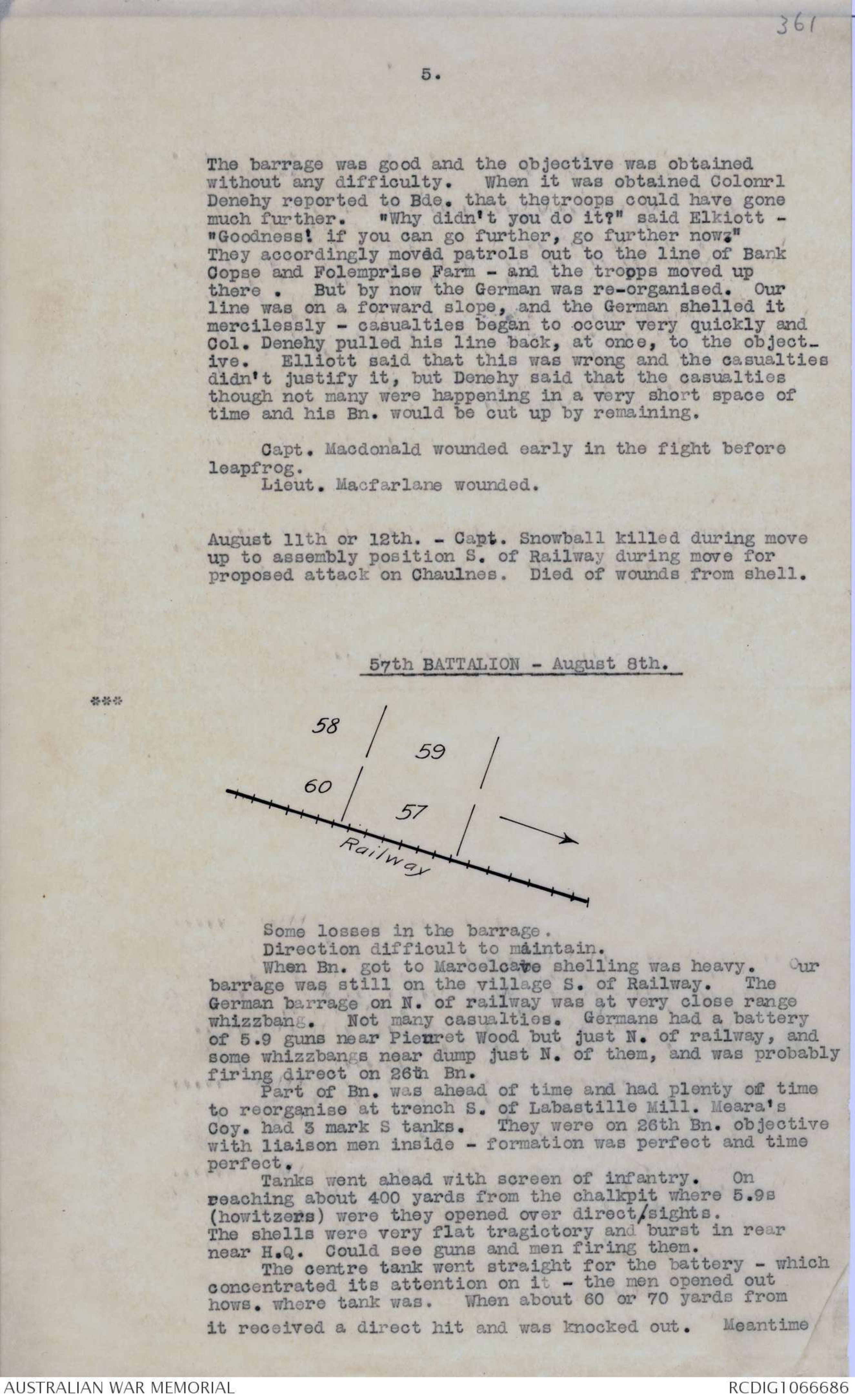
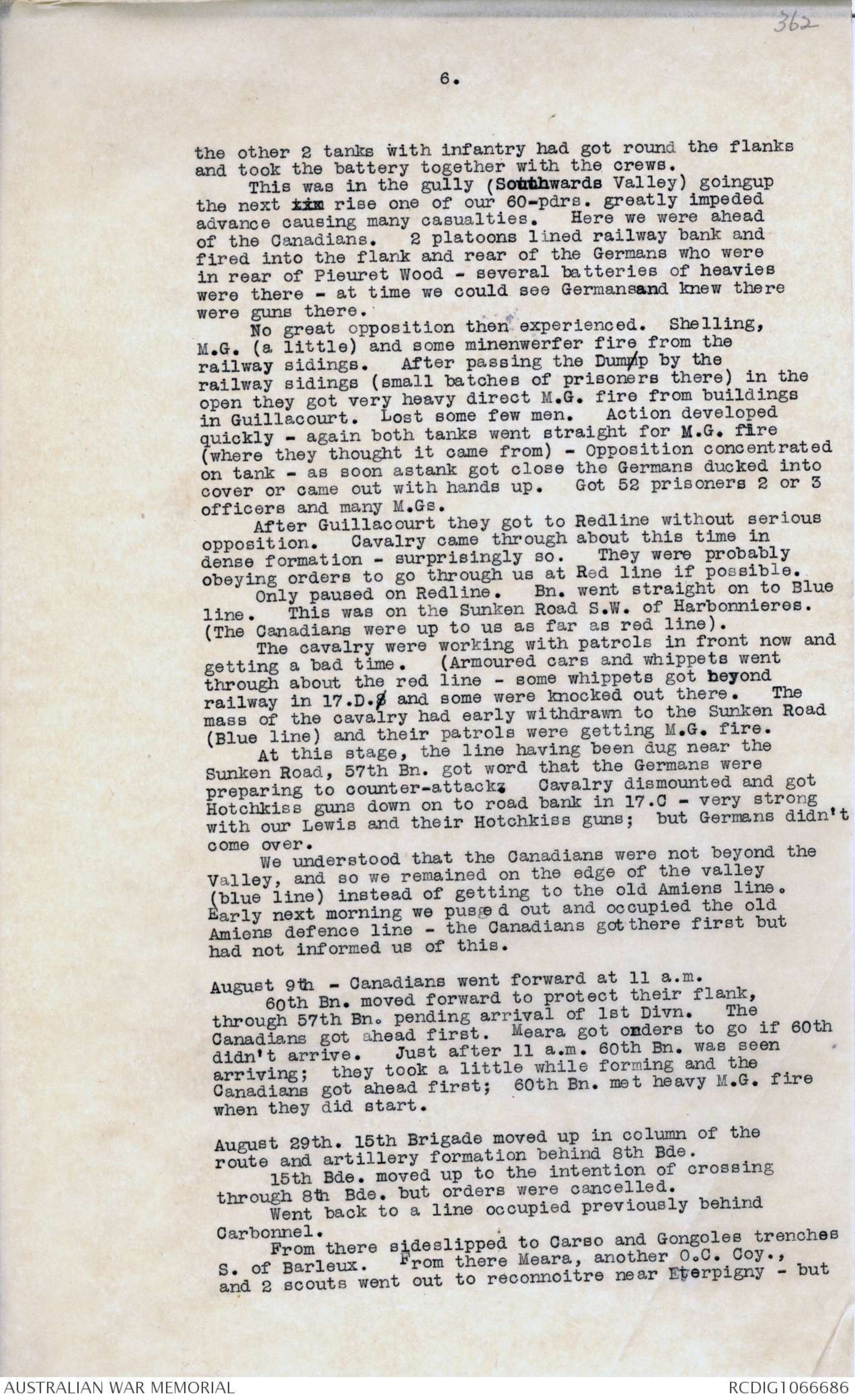
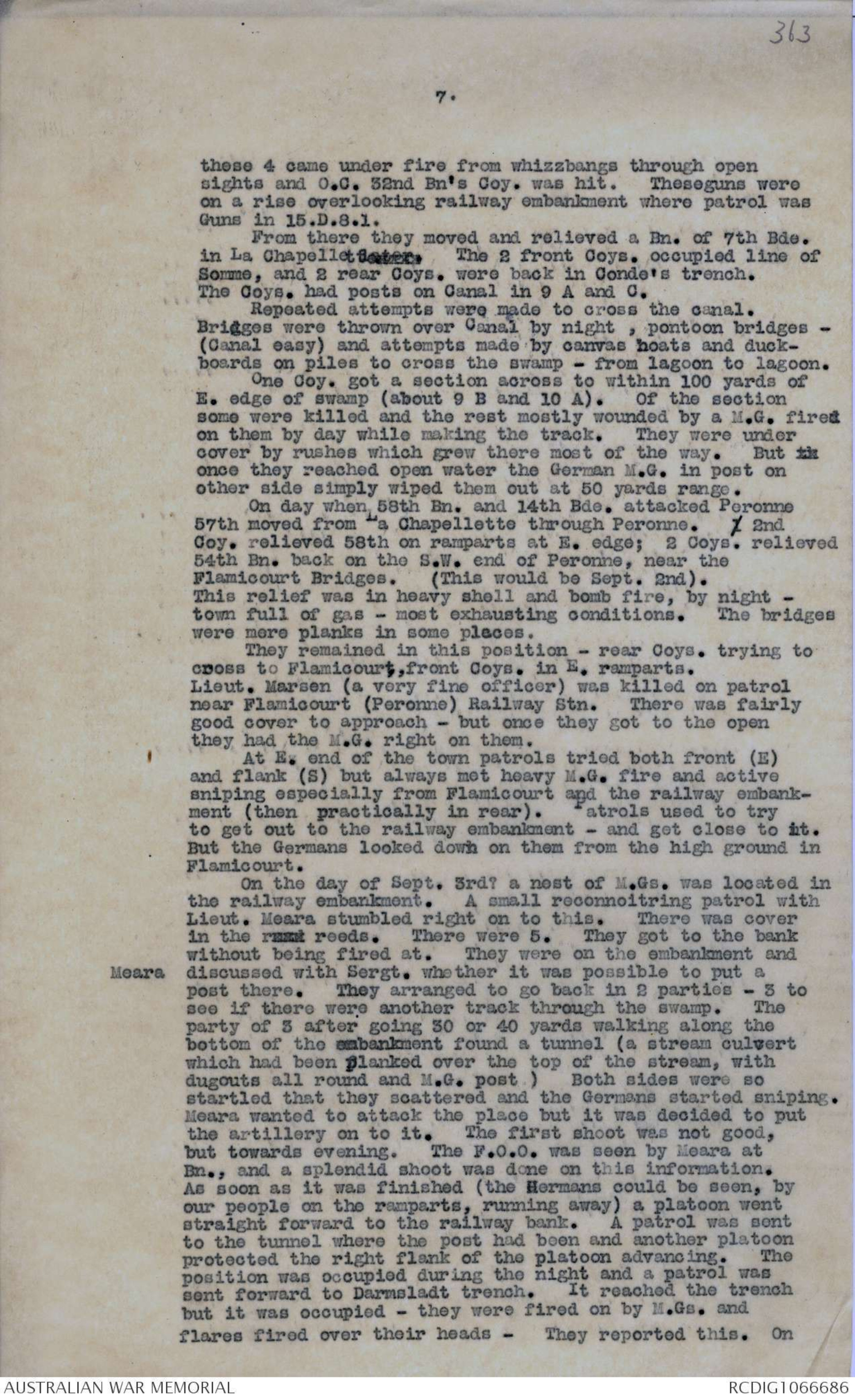
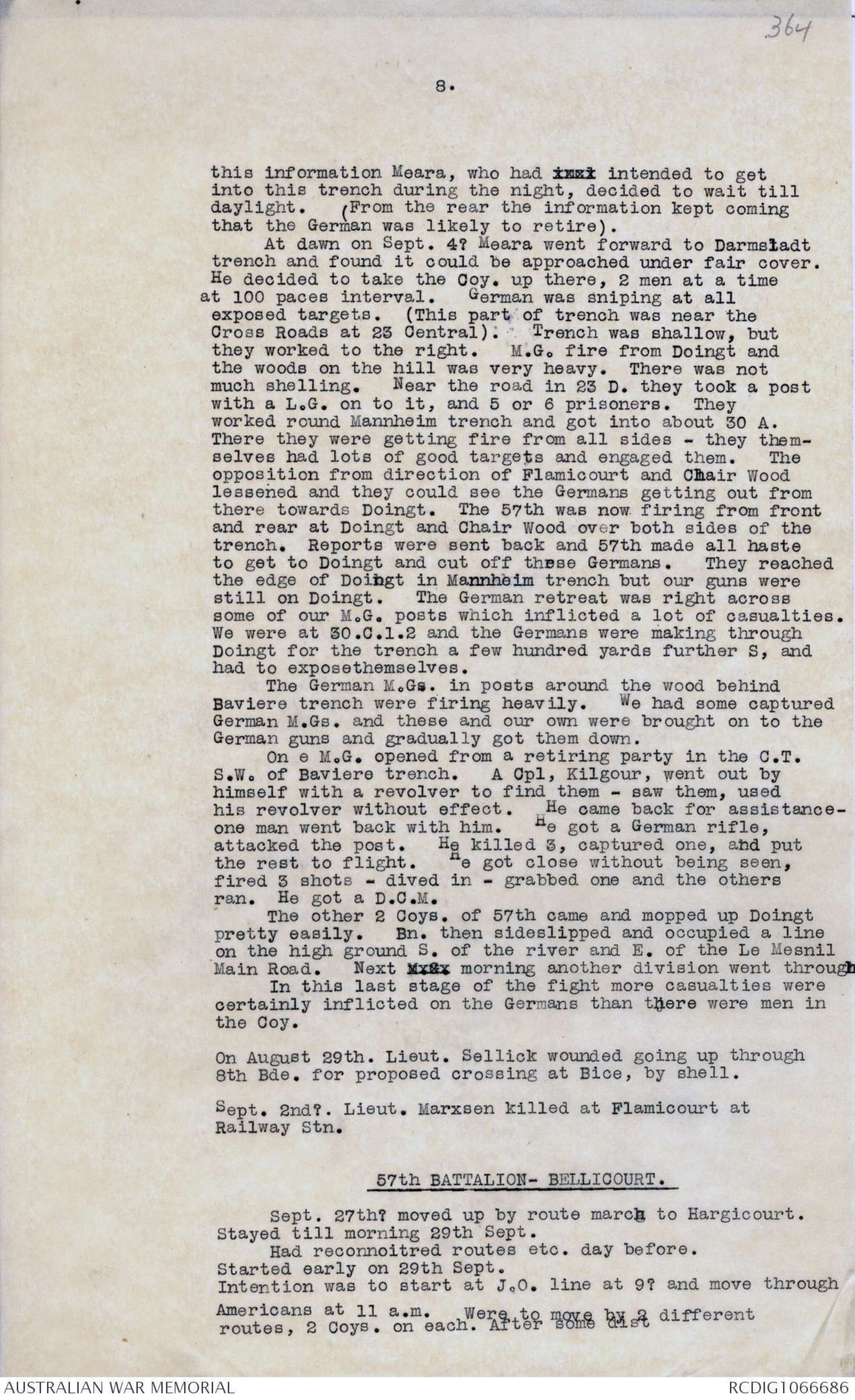
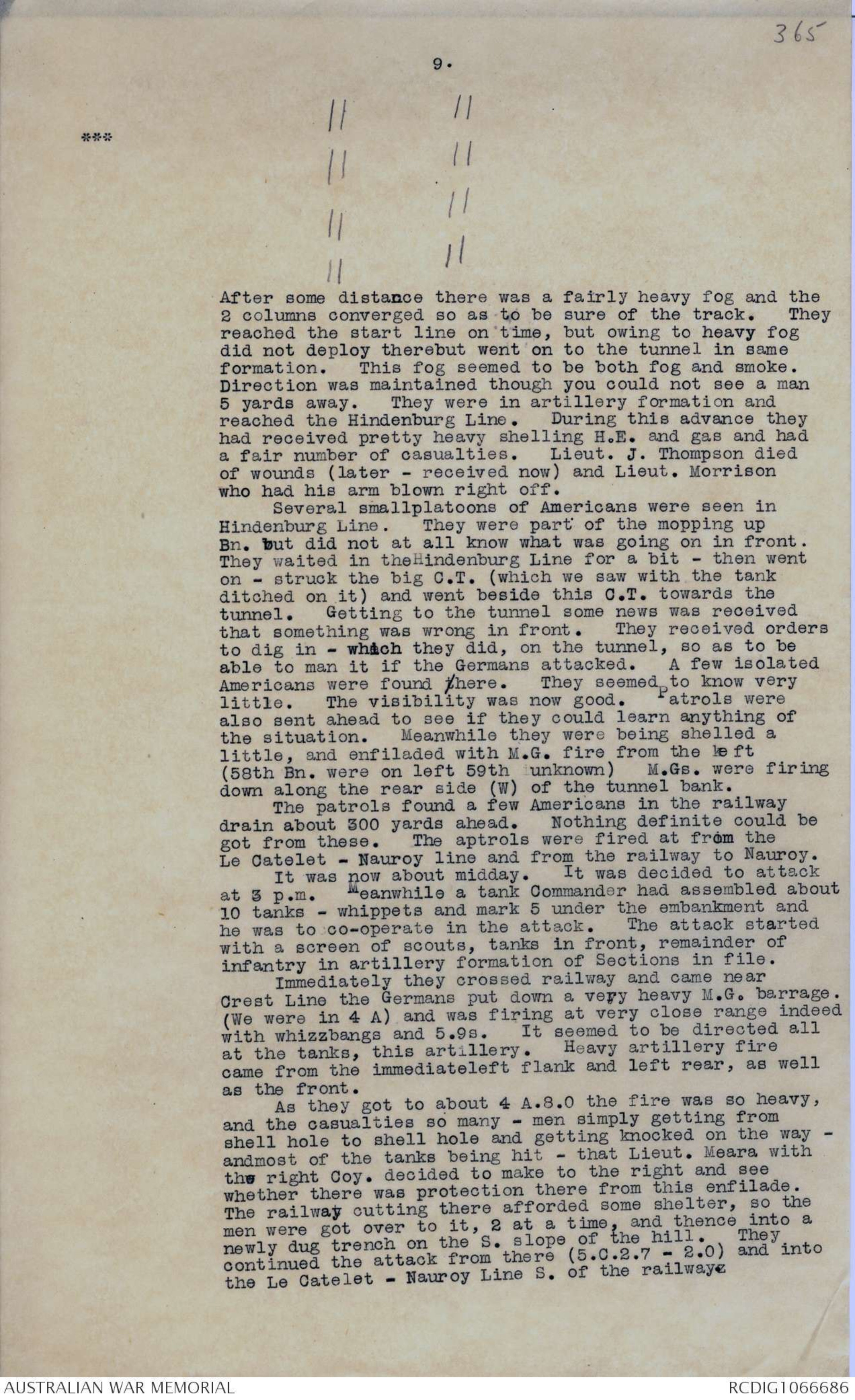
[*356*]
of days after this fight, with Capt Towl and we discovered
that the Huns must have occupied the trenches after "A"
Company had got out for they had buried Lieut. Ashmead
very near the spot where he was killed. I may say that
the Huns took the boots off every man killed in this
"stunt".
I do not think I can give you any more information
re this "stunt" but if you try this 10th A.I.Brigade H.Q.
you may get more. I know Capt. Towl wrote an account
of the "Stunt" and that one copy was sent to Brigade
Headquarters and another went into the 37th Battalion records
It was in this "stunt" that Capt. Towl gained the D.S.O.
After this "stunt" the Battalion had a few days rest
and then moved forward again to the TINCOURT-BERNES Area.
We had tea at TINCOURT and afterwards Capt. Towl and three
other Company o/c, went forward to make a reconnaissance
of the new line near BERNES.
The Company went along about two hours later and on
arrival we were informed that Capt. Towl had been seriously,
wounded. It appears he and an officer from the Company
holding the line, went along examining the front and
trying to get into touch with the people on the right and
when ^in the village of BERNES an 8" shell fell near them
wounding both. Capt. Towl was unconscious but the other
officer was wounded in the leg. He managed to crawl to
the trench (took him about 20 minutes) and had assistance
sent out to Capt. Towl.
Capt. Towl was taken to the Dressing station from
where he was removed to a Casualty Clearing Station near
PERONNE but he died a couple of days later.
Capt. Towl was always a very efficient and popular
officer, his loss was sincerely deplored by all ranks of
the Battalion.
[*357*]
57th BATTALION - Aug 8th
Aug. 9th
Flamicourt.
Bellicourt.
60th BATTALION - (ditto)
Col. Elliott was hit on the 25th April at Anzac
extending Bn. - his H.Q. was in White Gully and he was
extending Bn. across tho Hill Southwards. Shot on the
heel.
He was hit on Aug. 8th when speaking to a man in a
tank.
57th BATTALION. August 8th. Col. Denehy.
The Germans certainly saw us forming up (saw the
tanks Denehy thinks) and put down a barrage which fell,
however, behind the forming up position - few casualties.
When 57th Bn. moved it was densely misty - and the
2 platoons on the left of the Bn. got across on to the
right - otherwise there was little went wrong.
As they got near to the old German gun positions the
Germans had 5.9 guns ?hows. firing direct over their
sights at them. There was some fairly hard fighting in
the old German gun positions.
That finished the heavy fighting for that day.
After the 57th Bn. took up the fight all that they had
was a pretty heavy barrage laid down by the German
artillery - not direct fire this time - to pass through after
leaving the halt line.
Then the cavalry came up and formed mass behind
Harbonnieres. The Germans put up a M.G. fight at
Harbonnieres. The 57th Bn. was moving in artillery
formation and the cavalry moved through them. As the
cavalry went on the guns were still barraging and some
shorts caught them and emptied several saddles. The
cavalry scooped a fair number of prisoners in the
Harbonnieres Valley - and from that time on the fighting
ahead of the 57th Bn. was done by the cavalry. Ahead of
the 57th Bn. objective was the old ? German line. The
57th Bn. when it reached its objective did not stay still.
It had been told to exploit if possible, so it went on
and got into the old ? German line.
August 9th. Next day when the Canadians at 11 a.m.
were to attack and our 1st Divn. on their left the 1st
Divn. was many miles in rear - and so the 57th was just
about to hop over when 60th Bn. was ordered to do so -
and had some fairly tough fighting.
Peronne.
When 5th Divn. reached the Somme at the end of August
57th Bn, was to attempt the Somme Crossing. They and
th
[*358*]
2.
the engineers did this by building a causeway, patrolling in
punts and so on. The Germans let them build - the Canal
was no difficulty - the difficulty was the 500 to 1,000 yards
of marsh. They constructed a path (? mended an old German
one). But the moment they tried to push men across it
they were put off with direct whizzbang fire and M.G. fire.
(General Elliott was leading a party of the Bde. himself
when he fell into the water - he was also wounded in this
stage of the fighting).
Eventually 57th Bn. was put in further North and
relieved 54th Bn. in the S.W. of the town and 58th Bn. in
the E. of the town. They had to tru and get away to D
Flamicourt on the S. side.
*** Diagram - see original document
There was a causeway across the moat on the S. side and the
German allowed them to get patrols across it on to the railway;
but he would not allow them to send a party - and
the moment they tried to do so they had the losses.
(I think it was in this they lost one valuable officer and
some men. They tried it at Gen. Elliott's urgent wish-
against the Colonel's opinion). They also tried to get
out E. of the town towards the railway cutting with a
party (? under Capt. Mearer?) got out there but was seenby
the Germans who dodged back through a tunnel, got on to the
bank of the railway cutting and fired down at them. Our
party had to scatter and got back in that way without loss.
The Germans after some days made up their minds to
retire. As we noticed the retirement the crossing was
attempted again from the E. of the town and also at the S.W.
and was effected. The movement of thetroops Southwards
across the German front from the E. of Peronne was effected
under cover of smoke shell the artillery using their remaining
stocks (?remaining from when?)
*** Diagram - see original document
Bellicourt - September 29th.
The 57th Bn. coming up from near Templeuz found a very
heavy bombardment going on on the point where it was to form
up (the hill crest looking down from the W. upon Bellicourt.
The Colonrl accordingly decided to get over the ridge
(instead of staying there) as quickly as ever he could.
They found a trench leading sideways over the ridge and
worked through that and so down into the Bellicourt Valley.
The advance was to have been by Coys. in artillery formation
so
*** Diagram - see original document
The Colonel took the two right Coys. -and someone else
the other two and they worked separately down to the
Hindenburg line. As they got
[*359*]
3.
the Valley they got into dense smoke and fog - far thicker
than that of August 8th - so thick that they could not
see 10 yards ahead.
Their only guide was that they knew there was a line
of telegraph poles which ran down the hill to Bellicourt
- into the S. of Bellicourt. They didn't take the road
because they knew it would be shelled. They struck these
poles. The wired were trailing from the cross pieces;
or else, when the top was entirely broken off, the wire
was lying beside the poles on the ground. The C.O. got
his half Bn. here into one single line - not a good
formation for a battlefield but what else could he do. He
and the I.O. went ahead stooping down to see the wires and
follow them to the next post. When the post was reached
the one ahead would shout "Found it," and they would come
up to him.
They got through old wire - very tangled - and from
the look of the place the C.O. guessed they must now be
by the Hindenburg line. He accordingly halted the Bn.
and struck off Northwards to see if he could find the road -
which he knew was now N. of him - and which he ought to
strike at a cutting. He found it about 100 or 200 yards
away. He had given Bn. strict orders not to move, so he
came back to them and found them where they had been.
While they waited in the fog 3 Germans without arms
suddenly stumbled in upon them. "Merci Pardon'." they
began to cry. The men looked up at them laughing and
motioned them the way to go - and off they went, very
pleased, in the direction of our rear. Extended a line
of men from them (in the ordinary way, each knocking the
next man's back) from there to the road - and then marched
by that line.
The fog cleared as they got to the road and the enemy
just then began to shell it heavily. They got across
quickly and into a good trench the other side which (he
took it) must be the 2nd Hindenburg trench of the first
system.
He got the men up it and just there in came their other
two Coys. (who had been coming down separate) and also the
58th Bn. from further N. The 57th now worked round (where
their route was intended to be) N. of the town.
In the trench where they had got to a party of about
10 Americans with bayonets came down the trench. Denehy
asked who they were .They said they were moppers up, and
they were dealing with dugouts. Denehy asked what trench
this was - the Americans said it was the 2nd trench. This
turned out to be right.
The Bn. was led off in two long single files through
the wire of the system N. of Bellicourt. They had to go in
this formation for the wire was very thick and there were
few gaps.
As they came through it and clear of it, N. of the
town, they saw ahead the mound of spoil from the Hindenburg
tunnel. On top of this they could see men moving in
bunches. Suddenly it vecame evident that one of these men
was waving to them and trying to prevent them from coming.
However, they went on. They found that these were
Americans; and that they were occupying this embankment
over the tunnel (which here, of course, is hidden 90 or 100
feet below in the bowels of the earth) .There were a lot
of others in the tunnel dugouts hopelessly at sea as to
what was happening or waht they were doing; and without
any knowledge of what was happening ahead.
[*360*]
4.
A few isolated groups could be seen ahead by the
railway and about them a few bullets whizzed past from
the rear. Col. Denehy told his men to dig in as fast
as they could.
The 58th Bn. was in the 2nd Hindenburg trench on
the left; the 59th Bn. could not benn seen at all - they
had (through this was not known) struck trouble away
back by Quennemont or Malakoff Farm, and were fighting
their way through.
The C.O. decided to dig in and report the position
to Bde. The Bn. worked up to the isolated Americans
ahead and reported. Then orders came from Divn. to
push on. The Americans clearly had failed (it was
thought they had when news was so scarce in the early
hours and when the few wounded men seemed to know nothing
at all about it - prisoners ahd also passed early under
absurdly strong guards according to our experience of
Americans.
The order was given for an attack of at 3 p.m. with
a barrage. What happened to the barrage Denehy doesn't
know - he thinks they fired on a wrong map reference (?
were they prohibited by 4th Army from firing at all).
Anyway, some men thought the guns fired somewhere else
they attacked. the The tanks were all knocked out on the
hill. The 57th got into the Nauroy line on the S. and
S.W. of Cabaret Wood Farm; the 58th got some men into
the trench on the N.W. of it. The C.O. of 58th kept
insisting that they were in touch (but they were not)
in the trench. What happened was that 58th had its night
*** Diagram - see original document
out of the trench along a road and this was in touch with
57th Bns supports. The resistance from the Farm was very
strong. But the men got into the trenches and there was
bomb fighting going on in the gap between 57th and 58th.
(The right of 58th Bn. earlier in the day, had made a
good advance under Mearer? by working around the railway
cutting on the right when the left was held up).
A defensive flank was thrown back towards 59th Bn. by
an advance of support Coys. (after the first advance towards
Cabaret Wood Farm). (An American Bn. reported to C.O.
57th that night and was advised by him to make a flank
echeloned on left rear). Next day (Sept. 30th) the x
53rd Bn. came through and bombed up to the N. and cleared
Cabaret Farm in the process, through there were Germans
left behind in it.
Sept. 1st. This day an advance was made down on a long
front slantwise from N.W. to S.E. (A.22 Central to H.15
Central) in order to give 2nd Divn. a good hopping off line
[*361*]
5.
The barrage was good and the objective was obtained
without any difficulty. When it was obtained Colonrl
Denehy reported to Bde. that thetroops could have gone
much further. "Why didn't you do it?" said Elkiott -
"Goodness! if you can go further, go further now."
They accordingly moved patrols out to the line of Bank
Copse and Folemprise Farm - and the troops moved up
there. But by now the German was re-organised. Our
line was on a forward slope, and the German shelled it
mercilessly - casualties began to occur very quickly and
Col. Denehy pulled his line back, at once, to the objective.
Elliott said that this was wrong and the casualties
didn't justify it, but Denehy said that the casualties
though not many were happening in a very short space of
time and his Bn. would be cut up by remaining.
Capt. Macdonald wounded early in the fight before
leapfrog.
Lieut. Macfarlane wounded.
August 11th or 12th. - Capt. Snowball killed during move
up to assembly position S. of Railway during move for
proposed attack on Chaulnes. Died of wounds from shell.
57th BATTALION - August 8th.
*** Diagram - see original document
Some losses in the barrage.
Direction difficult to maintain.
When Bn. got to Marcelcave shelling was heavy. Our
barrage was still on the village S. of Railway. The
German barrage on N. of railway was at very close range
whizzbang. Not many casualties. Germans had a battery
of 5.9 guns near Pieuret Wood but just N. of railway, and
some whizzbangs near dump just N. of them, and was probably
firing direct on 26th Bn.
Part of Bn. was ahead of time and had plenty of time
to reorganise at trench S. of Labastille Mill. Meara's
Coy. had 3 mark S tanks. They were on 26th Bn. objective
with liaison men inside - formation was perfect and time
perfect.
Tanks went ahead with screen of infantry. On
reaching about 400 yards from the chalkpit where 5.9s
(howitzers) were they opened over direct sights.
The shells were very flat tragictory and burst in rear
near H.Q. Could see guns and men firing them.
The centre tank went straight for the battery - which
concentrated its attention on it - the men opened out
hows. where tank was. When about 60 or 70 yards from
it received a direct hit and was knocked out. Meantime
[*362*]
6.
the other 2 tanks with infantry had got round the flanks
and took the battery together with the crews.
This was in the gully (Southwards Valley) goingup
the next xxx rise one of our 60-pdrs. greatly impeded
advance causing many casualties. Here we were ahead
of the Canadians. 2 platoons lined railway bank and
fired into the flank and rear of the Germans who were
in rear of Pieuret Wood - several batteries of heavies
were there - at time we could see Germansand knew there
were guns there.
No great opposition then experienced. Shelling,
M.G. (a little) and some minenwerfer fire from the
railway sidings. After passing the Dummp by the
railway sidings (small batches of prisoners there) in the
open they got very heavy direct M.G. fire from buildings
in Guillacourt. Lost some few men. Action developed
quickly - again both tanks went straight for M.G. fire
(where they thought it came from) - Opposition concentrated
on tank - as soon astank got close the Germans ducked into
cover or came out with hands up. Got 52 prisoners 2 or 3
officers and many M.Gs.
After Guillacourt they got to Redline without serious
opposition. Cavalry came through about this time in
dense formation - surprisingly so. They were probably
obeying orders to go through us at Red line if possible.
Only paused on Redline. Bn. went straight on to Blue
line. This was on the Sunken Road S.W. of Harbonnieres.
(The Canadians were up to us as far as red line).
The cavalry were working with patrols in front now and
getting a bad time. (Armoured cars and whippets went
through about the red line - some whippets got beyond
railway in 17.D.S and some were knocked out there. The
mass of the cavalry had early withdrawn to the Sunken Road
(Blue line) and their patrols were getting M.G. fire.
At this stage, the line having been dug near the
Sunken Road, 57th Bn. got word that the Germans were
preparing to counter-attack. Cavalry dismounted and got
Hotchkiss guns down on to road bank in 17.C - very strong
with our Lewis and their Hotchkiss guns; but Germans didn't
come over.
We understood that the Canadians were not beyond the
Valley, and so we remained on the edge of the valley
(blue line) instead of getting to the old Amiens line.
Early next morning we puse d out and occupied the old
Amiens defence line - the Canadians got there first but
had not informed us of this.
August 9th - Canadians went forward at 11 a.m.
60th Bn. moved forward to protect their flank,
through 57th Bn. pending arrival of 1st Divn. The
Canadians got ahead first. Meara got orders to go if 60th
didn't arrive. Just after 11 a.m. 60th Bn. was seen
arriving; they took a little while forming and the
Canadians got ahead first; 60th Bn. met heavy M.G. fire
when they did start.
August 29th. 15th Brigade moved up in column of the
route and artillery formation behind 8th Bde.
15th Bde. moved up to the intention of crossing
through 8th Bde. but orders were cancelled.
Went back to a line occupied previously behind
Carbonnel.
From there sideslipped to Carso and Gongoles trenches
S. of Barleux. From there Meara, another O.C. Coy,
and 2 scouts went out to reconnoitre near Eterpigny - but
[*363*]
7.
these 4 came under fire from whizzbangs through open
sights and O.C. 32nd Bn's Coy. was hit. Theseguns were
on a rise overlooking railway embankment where patrol was
Guns in 15.D.8.1.
From there they moved and rolieved a Bn. of 7th Bde.
in La Chapellette. The 2 front Coys. occupied line of
Somme, and 2 rear Coys, were back in Conde's trench.
The Coys. had posts on Canal in 9 A and C.
Repeated attempts were made to cross the canal.
Bridges were thrown over Canal by night, pontoon bridges -
(Canal easy) and attempts made by canvas boats and duckboards
on piles to cross the swamp - from lagoon to lagoon.
One Coy. got a section across to within 100 yards of
E. edge of swamp (about 9 B and 10 A). Of the section
some were killed and the rest mostly wounded by a M.G. fired
on them by day while making the track. They were under
cover by rushes which grew there most of the way. But th
once they reached open water the German M.G. in post on
other side simply wiped them out at 50 yards range.
On day when 58th Bn. and 14th Bde. attacked Peronne
57th moved from La Chapellette through Peronne. Z 2nd
Coy. relieved 58th on ramparts at E. edge; 2 Coys. relieved
54th Bn. back on the S.W. end of Peronne, near the
Flamicourt Bridges. (This would be Sept. 2nd).
This relief was in heavy shell and bomb fire, by night -
town full of gas - most exhausting conditions. The bridges
were mere planks in some places.
They remained in this position - rear Coys. trying to
cross to Flamicourt, front Coys. in E. ramparts.
Lieut. Marsen (a very fine officer) was killed on patrol
near Flamicourt (Peronne) Railway Stn. There was fairly
good cover to approach - but once they got to the open
they had the M.G. right on them.
At E. end of the town patrols tried both front (E)
and flank (S) but always met heavy M.G. fire and active
sniping especially from Flamicourt and the railway embankment
(then practically in rear). Patrols used to try
to get out to the railway embankment - and get close to it.
But the Germans looked down on them from the high ground in
Flamicourt.
On the day of Sept. 3rd? a nest of M.Gs. was located in
the railway embankment. A small reconnoitring patrol with
Lieut. Meara stumbled right on to this. There was cover
in the rxxx reeds. There were 5. They got to the bank
without being fired at. They were on the embankment and
[*Meara*] discussed with Sergt. whether it was possible to put a
post there. They arranged to go back in 2 parties - 3 to
see if there were another track through the swamp. The
party of 3 after going 30 or 40 yards walking along the
bottom of the embankment found a tunnel (a stream culvert
which had been planked over the top of the stream, with
dugouts all round and M.G. post.) Both sides were so
startled that they scattered and the Germans started sniping.
Meara wanted to attack the place but it was decided to put
the artillery on to it .The first shoot was not good,
but towards evening. The F.O.O. was seen by Meara at
Bn., and a splendid shoot was done on this information.
As soon as it was finished (the Germans could be seen, by
our people on the ramparts, running away) a platoon went
straight forward to the railway bank. A patrol was sent
to the tunnel where the post had been and another platoon
protected the right flank of the platoon advancing. The
position was occupied during the night and a patrol was
sent forward to Darmsladt trench. It reached the trench
but it was occupied - they were fired on by M.Gs. and
flares fired over their heads - They reported this. On
[*364*]
8.
this information Meara, who had xxxx intended to get
into this trench during the night, decided to wait till
daylight. (From the rear the information kept coming
that the German was likely to retire).
At dawn on Sept. 4? Meara went forward to Darmstadt
trench and found it could be approached under fair cover.
He decided to take the Coy. up there, 2 men at a time
at 100 paces interval. German was sniping at all
exposed targets. (This part of trench was near the
Cross Roads at 23 Central). Trench was shallow, but
they worked to the right. M.G. fire from Doingt and
the woods on the hill was very heavy. There was not
much shelling. Near the road in 23 D. they took a post
with a L.G. on to it, and 5 or 6 prisoners. They
worked round Mannheim trench and got into about 30 A.
There they were getting fire from all sides - they themselves
had lots of good targets and engaged them. The
opposition from direction of Flamicourt and Chair Wood
lessened and they could see the Germans getting out from
there towards Doingt. The 57th was now firing from front
and rear at Doingt and Chair Wood over both sides of the
trench. Reports were sent back and 57th made all haste
to get to Doingt and cut off these Germans. They reached
the edge of Doingt in Mannheim trench but our guns were
still on Doingt. The German retreat was right across
some of our M.G. posts which inflicted a lot of casualties.
We were at 30.C.1.2 and the Germans were making through
Doingt for the trench a few hundred yards further S, and
had to exposethemselves.
The German M.Gs. in posts around the wood behind
Baviere trench were firing heavily. We had some captured
German M.Gs. and these and our own were brought on to the
German guns and gradually got them down.
One M.G. opened from a retiring party in the C.T.
S.W. of Baviere trench. A Cpl, Kilgour, went out by
himself with a revolver to find them - saw them, used
his revolver without effect. He came back for assistance-
one man went back with him. He got a German rifle,
attacked the post. He killed 3, captured one, and put
the rest to flight. He got close without being seen,
fired 3 shots - dived in - grabbed one and the others
ran. He got a D.C.M.
The other 2 Coys. of 57th came and mopped up Doingt
pretty easily. Bn. then sideslipped and occupied a line
on the high ground S. of the river and E. of the Le Mesnil
Main Road. Next xxxx morning another division went through
In this last stage of the fight more casualties were
certainly inflicted on the Germans than there were men in
the Coy.
On August 29th. Lieut. Sellick wounded going up through
8th Bde. for proposed crossing at Bice, by shell.
Sept. 2nd?. Lieut. Marxsen killed at Flamicourt at
Railway Stn.
57th BATTALION- BELLICOURT.
Sept. 27th? moved up by route march to Hargicourt.
Stayed till morning 29th Sept.
Had reconnoitred routes etc. day before.
Started early on 29th Sept.
Intention was to start at J.O. line at 9? and move through
Americans at 11 a.m. Were to move by 2 different
routes, 2 Coys. on each. Alter some dist
[*365*]
9.
*** Diagram - see original document
After some distance there was a fairly heavy fog and the
2 columns converged so as to be sure of the track. They
reached the start line on time, but owing to heavy fog
did not deploy therebut went on to the tunnel in same
formation. This fog seemed to be both fog and smoke.
Direction was maintained though you could not see a man
5 yards away. They were in artillery formation and
reached the Hindenburg Line. During this advance they
had received pretty heavy shelling H.E. and gas and had
a fair number of casualties. Lieut. J. Thompson died
of wounds (later - received now) and Lieut. Morrison
who had his arm blown right off.
Several smallplatoons of Americans were seen in
Hindenburg Line. They were part of the mopping up
Bn. but did not at all know what was going on in front.
They waited in theHindenburg Line for a bit - then went
on - struck the big C.T. (which we saw with the tank
ditched on it) and went beside this C.T. towards the
tunnel. Getting to the tunnel some news was received
that something was wrong in front. They received orders
to dig in - which they did, on the tunnel, so as to be
able to man it if the Germans attacked. A few isolated
Americans were found there. They seemed, to know very
little. The visibility was now good. Patrols were
also sent ahead to see if they could learn anything of
the situation. Meanwhile they were being shelled a
little, and enfiladed with M.G. fire from the left
(58th Bn. were on left 59th unknown) M.Gs. were firing
down along the rear side (W) of the tunnel bank.
The patrols found a few Americans in the railway
drain about 300 yards ahead. Nothing definite could be
got from these. The aptrols were fired at from the
Le Catelet - Nauroy line and from the railway to Nauroy.
It was now about midday. It was decided to attack
at 3 p.m. Meanwhile a tank Commander had assembled about
10 tanks - whippets and mark 5 under the embankment and
he was to co-operate in the attack. The attack started
with a screen of scouts, tanks in front, remainder of
infantry in artillery formation of Sections in file.
Immediately they crossed railway and came near
Crest Line the Germans put down a very heavy M.G. barrage.
(We were in 4 A), and was firing at very close range indeed
with whizzbangs and 5.9s. It seemed to be directed all
at the tanks, this artillery. Heavy artillery fire
came from the immediateleft flank and left rear, as well
as the front.
As they got to about 4 A.8.0 the fire was so heavy,
and the casualties so many - men simply getting from
shell hole to shell hole and getting knocked on the way -
andmost of the tanks being hit - that Lieut. Meara with
the right Coy. decided to make to the right and see
whether there was protection there from this enfilade.
The railway cutting there afforded some shelter, so the
men were got over to it, 2 at a time, and thence into a
newly dug trench on the S. slope of the hill. They
continued the attack from there (5.C.2.7 - 2.0) and into
the Le Catelet - Nauroy Line S. of the railwayz
 Deb Parkinson
Deb ParkinsonThis transcription item is now locked to you for editing. To release the lock either Save your changes or Cancel.
This lock will be automatically released after 60 minutes of inactivity.